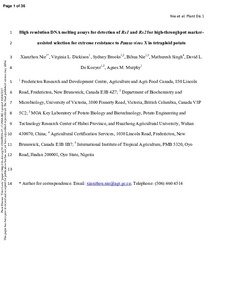| dc.contributor.author | Nie, X. |
| dc.contributor.author | Dickison, V.L. |
| dc.contributor.author | Brooks, S. |
| dc.contributor.author | Nie, B. |
| dc.contributor.author | Singh, M. |
| dc.contributor.author | Koeyer, D.L. de |
| dc.contributor.author | Murphy, A.M. |
| dc.date.accessioned | 2019-12-04T11:11:19Z |
| dc.date.available | 2019-12-04T11:11:19Z |
| dc.date.issued | 2017 |
| dc.identifier.citation | Nie, X., Dickison, V.L., Brooks, S., Nie, B., Singh, M., De Koeyer, D.L. & Murphy, A.M. (2017). High resolution DNA melting assays for detection of Rx1 and Rx2 for high-throughput marker-assisted selection for extreme resistance to Potato virus X in tetraploid potato. Plant Disease, 1-36. |
| dc.identifier.issn | 0191-2917 |
| dc.identifier.uri | https://hdl.handle.net/20.500.12478/2402 |
| dc.description.abstract | Assessment of the existing PCR-gel electrophoresis-based methods for detection of Rx1 and Rx2, the genes that independently control extreme resistance (ER) to Potato virus X (PVX), indicated that the 5Rx1F/5Rx1R primer pair led to reliable detection of Rx1 whereas the 106Rx2F/106Rx2R primer pair detected Rx2 despite some non-specific reactions in potato clones/cultivars without Rx2. However, the methodology is time consuming and does not differentiate the absence of Rx1/Rx2 from a failed PCR reaction. A newly designed primer pair that targets Rx1 and Rx2 as well as rx1 and rx2 produced an amplicon for all alleles. When the primer pair was combined with 5Rx1F/5Rx1R, respective amplicons were produced, although they were not distinguishable by regular agarose gel electrophoresis. When subjected to a high resolution DNA melting (HRM) assay, two distinct melting profiles for Rx1 and rx1, respectively, were detected. Triplex PCR-gel electrophoresis and -HRM assay for detection of Rx1, Rx2 and rx1/rx2 were also performed. The efficacy of the HRM assays were validated in potato cultivars/clones with known phenotypes, indicating its potential for high-throughput selection of potato clones/cultivars carrying Rx1 or Rx2. Duplex PCR-HRM assays of over 600 progeny from 12 crosses involving various parents correctly detected the presence or absence of Rx1 in each progeny, allowing accurate prediction of the phenotype. Progeny that tested positive for Rx1 by HRM exhibited ER to PVX whereas progeny that tested negative for Rx1 were susceptible to PVX infection. The genotype of each parent and the possible presence of Nx in two Rx1-possessing parents are also discussed. |
| dc.description.sponsorship | Agriculture and Agri-Food Canada |
| dc.format.extent | 1-36 |
| dc.language.iso | en |
| dc.subject | Gene |
| dc.subject | Potato |
| dc.subject | Dna |
| dc.subject | Genotypes |
| dc.subject | Potato Virus |
| dc.subject | High Resolution |
| dc.subject | Resistance |
| dc.subject | Cultivars |
| dc.title | High resolution DNA melting assays for detection of Rx1 and Rx2 for high-throughput marker assisted selection for extreme resistance to Potato virus X in tetraploid potato |
| dc.type | Journal Article |
| dc.description.version | Peer Review |
| cg.contributor.crp | Roots, Tubers and Bananas |
| cg.contributor.affiliation | Agriculture and Agri-Food Canada |
| cg.contributor.affiliation | University of Victoria |
| cg.contributor.affiliation | Huazhong Agricultural University |
| cg.contributor.affiliation | Agricultural Certification Services, Canada |
| cg.contributor.affiliation | International Institute of Tropical Agriculture |
| cg.isijournal | ISI Journal |
| cg.authorship.types | CGIAR and advanced research institute |
| cg.iitasubject | Genetic Improvement |
| cg.iitasubject | Plant Diseases |
| cg.iitasubject | Plant Genetic Resources |
| cg.journal | Plant Disease |
| cg.howpublished | Formally Published |
| cg.accessibilitystatus | Limited Access |
| local.dspaceid | 92369 |
| cg.targetaudience | Scientists |
| cg.identifier.doi | http://dx.doi.org/10.1094/pdis-07-17-0968-re |

